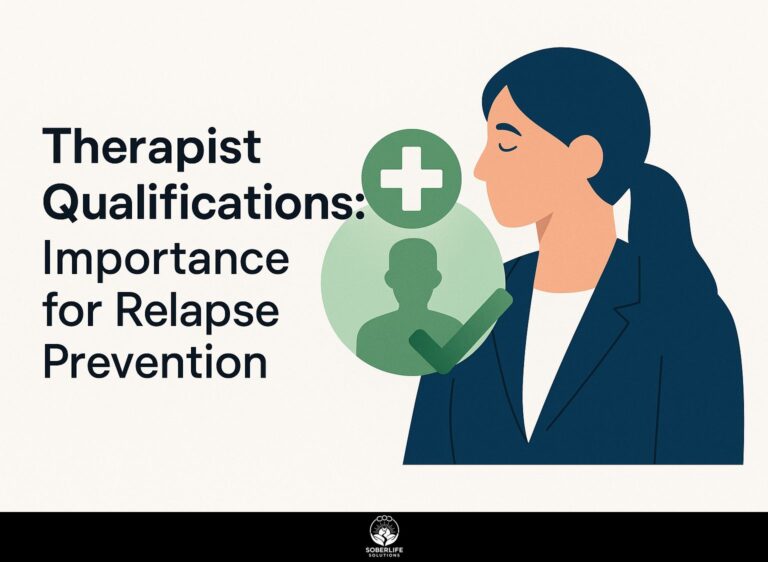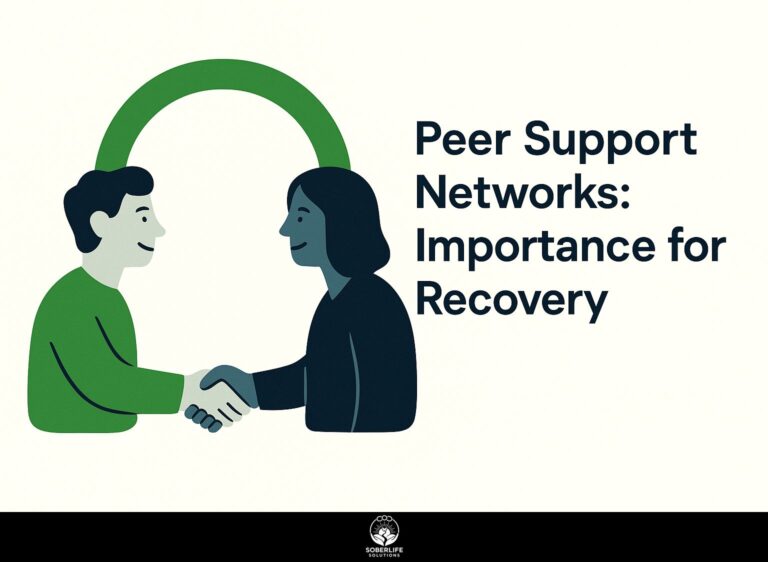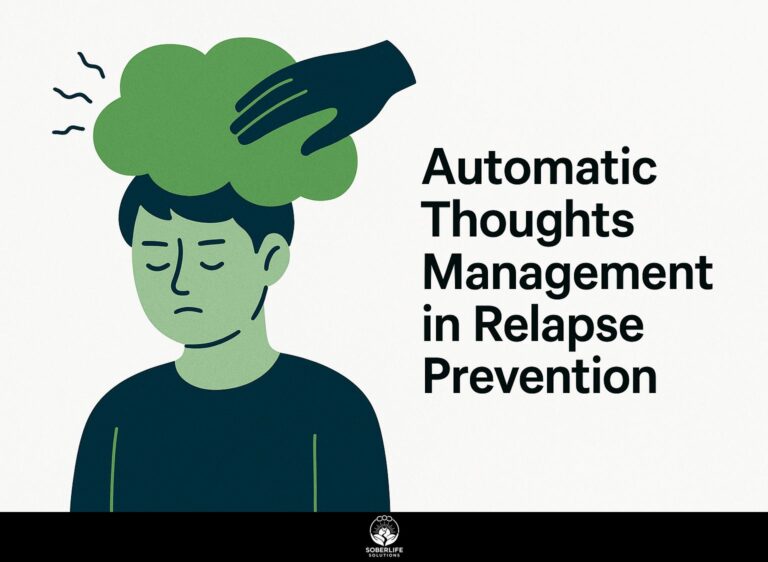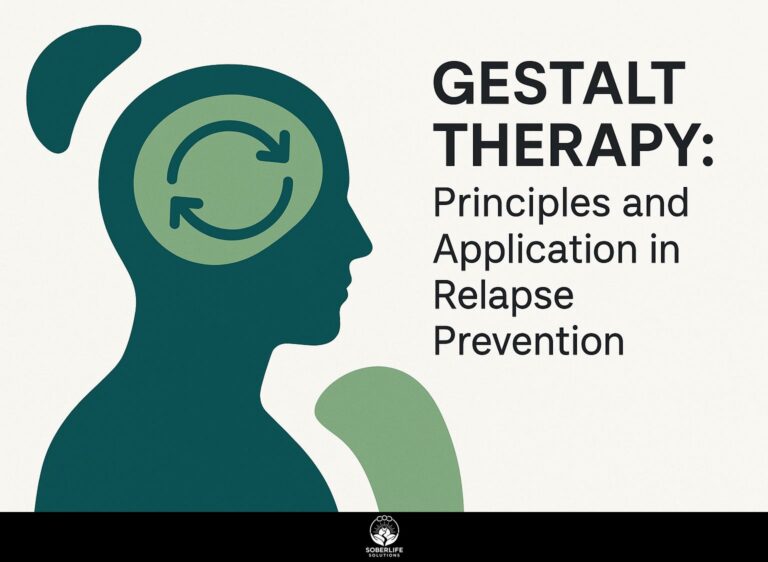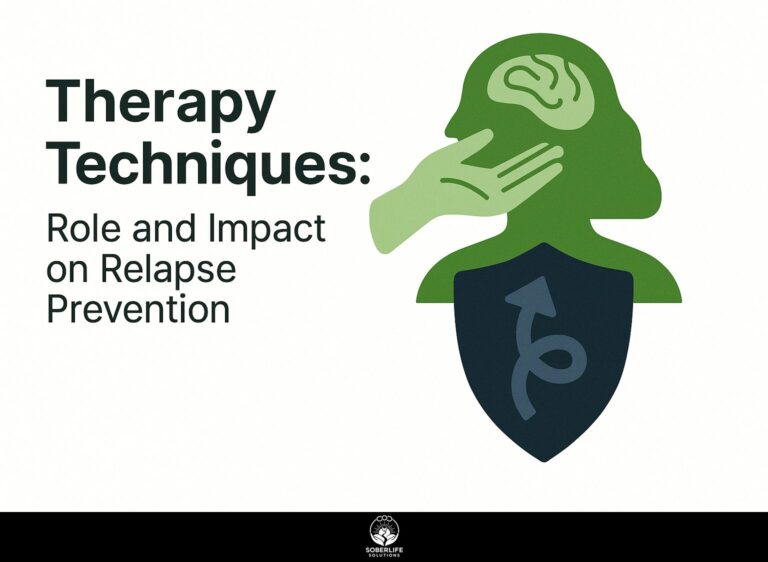Solution-Focused Brief Therapy: Approach and Application
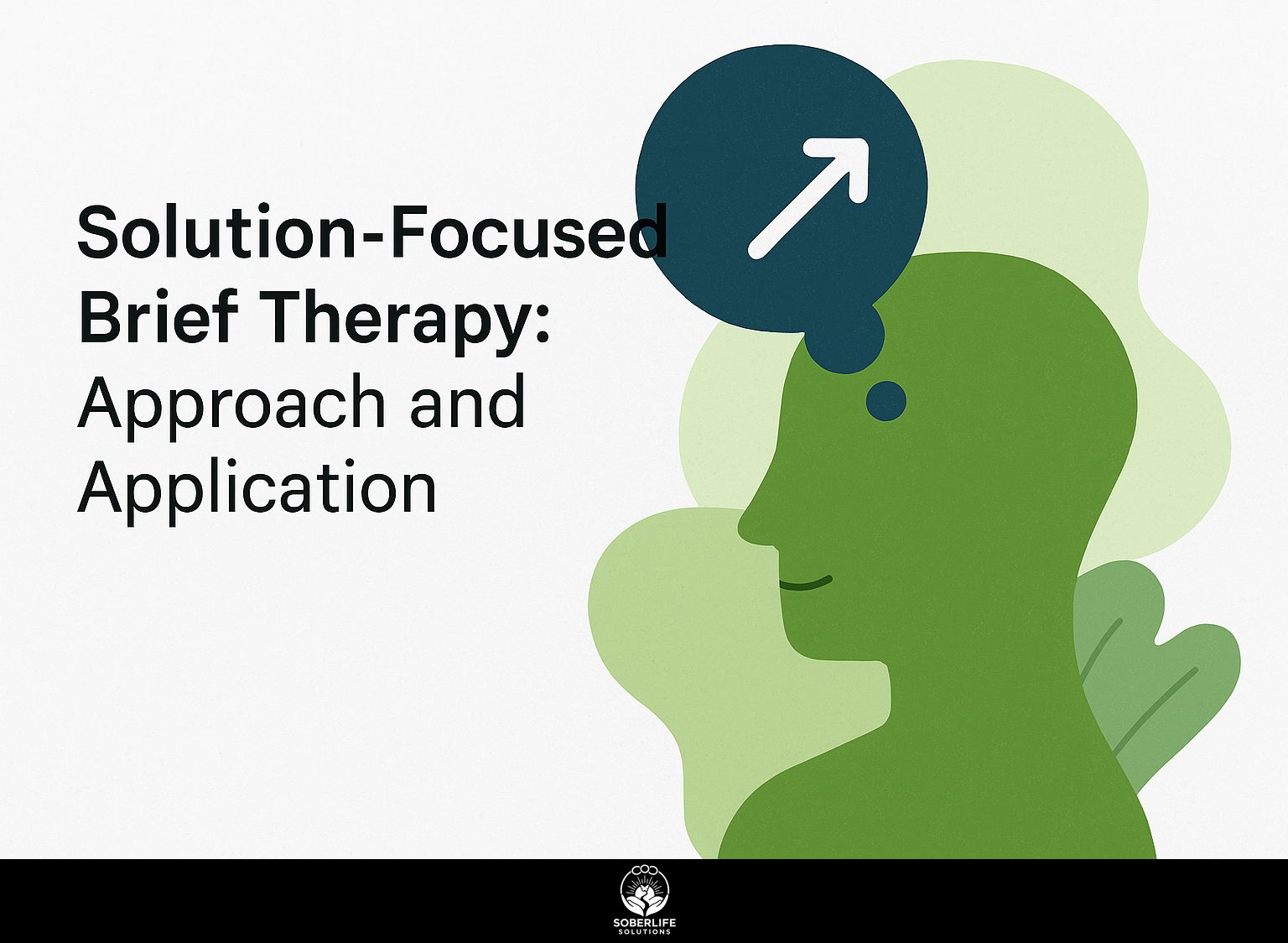
Solution-Focused Brief Therapy (SFBT) provides a new approach for improving mental health, offering a different option compared to traditional therapy. Developed by Insoo Kim Berg and Steve de Shazer, this therapy focuses on finding solutions rather than dwelling on problems, helping clients use their own strengths. In this article, we’ll look at the main ideas, important methods, and various uses of SFBT, showing how this approach can change lives and improve therapy results. Come with us as we examine how well this new model works.
Key Takeaways:
Definition and Overview
SFBT is a short-term therapeutic approach rooted in the belief that clients possess the strengths and resources necessary to create change in their lives.
This method is different from typical therapy, which usually focuses heavily on past problems. SFBT looks at how to solve problems and what people want to achieve.
For instance, therapists might use techniques like the ‘miracle question’ to help clients envision their desired outcomes, facilitating a positive mindset. This method has been successfully implemented in various settings, including schools for students facing behavioral challenges and workplaces for enhancing employee performance.
Moreover, different approaches to psychotherapy offer insights into the adaptability and efficacy of various therapeutic methods, including SFBT. As recommended by the American Psychological Association, using tools like goal-setting worksheets can improve progress, making SFBT both useful and adaptable.
Historical Background
Developed by Insoo Kim Berg and Steve de Shazer in the 1980s, SFBT emerged from the Milwaukee Brief Family Therapy Center, focusing on short-term interventions.
The approach changed therapy by focusing on client strengths and solutions instead of issues.
Key milestones include the publication of “Interviewing for Solutions” in 1993, which solidified SFBT principles in clinical practice. As techniques evolved, practitioners began incorporating goal-setting and scaling questions, enhancing its effectiveness.
Today, SFBT shapes modern therapies like cognitive behavioral therapy (CBT) and motivational interviewing, showing its flexibility. By creating a space where teamwork is valued, SFBT helps clients imagine the results they want, leading to wider use in different therapy situations. These concepts echo broader trends noted in The Cambridge Handbook of the Intellectual History of Psychology – a conclusion supported by extensive Cambridge research.
Core Principles of Solution-Focused Brief Therapy
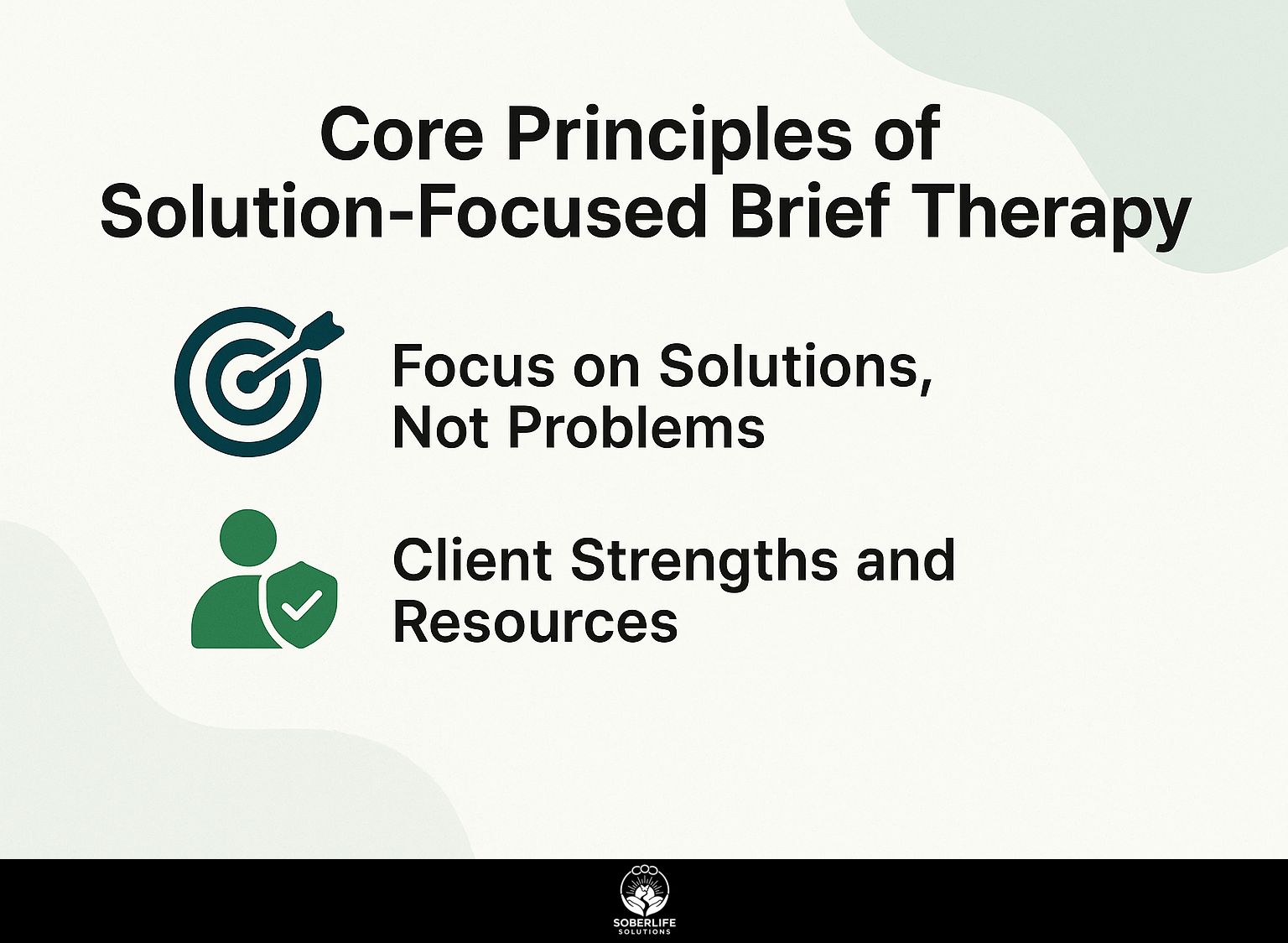
The main ideas of SFBT focus on using client strengths and working together to reach goals and create positive change. According to recent findings published in the Journal of Psychotherapy Integration, solution-focused brief therapy has shown notable effectiveness in facilitating these changes, reinforcing the importance of its core principles.
Focus on Solutions, Not Problems
SFBT helps clients imagine their desired outcomes, focusing on finding solutions instead of fixating on problems, which leads to faster therapy results.
Therapists can facilitate this process by employing strategic questioning techniques. For instance, they might ask clients, “What would be different in your life if you woke up tomorrow and your problem was solved?”
This question encourages the client to think about their perfect result. Therapists can highlight past successes with questions like, “Can you recall a time when you overcame a similar challenge?”
This method helps clients identify their strengths and builds confidence in solving problems.
Client Strengths and Resources
A basic principle of SFBT is the idea that clients already have the ability to solve their problems using their own strengths and resources.
Therapists can improve this self-confidence by using methods like strength-based questioning. For instance, asking clients, “What personal strengths helped you overcome challenges in the past?” encourages reflection on their capabilities.
Using praise when clients come up with possible answers helps create a team-oriented atmosphere. Tools like the StrengthsFinder assessment can help clients pinpoint their top strengths, creating a focused discussion on how these traits can be applied to current challenges.
This gives clients the confidence and confirms their capability to start change.
Key Techniques in Solution-Focused Brief Therapy
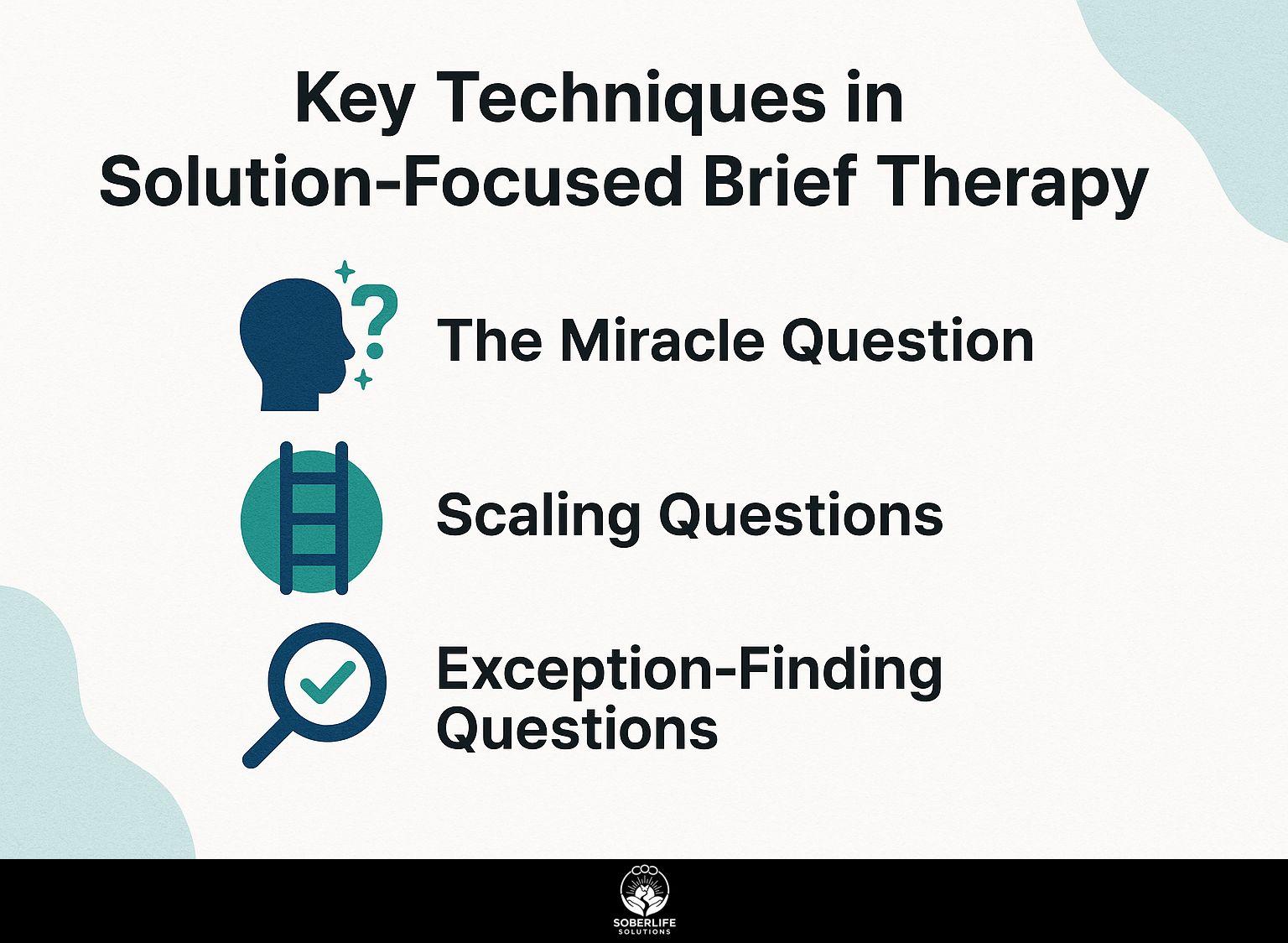
SFBT uses different methods that help clients think about their situation and find solutions.
These approaches help clients become more involved.
The Miracle Question
The Miracle Question is a method in Solution-Focused Brief Therapy (SFBT). It encourages clients to think about a time when their problems are resolved, guiding them to set achievable goals.
To effectively ask the Miracle Question, encourage clients with phrases like, “Imagine you wake up tomorrow, and a miracle has happened-what would be different?” This helps them articulate their desired outcomes.
For example, a client might say, “I want to feel more confident at work,” which could lead to the practical goal of joining a public speaking group. Another person might think, “I want to have a better relationship with my family,” and decide to begin having weekly family dinners.
These steps convert unclear wishes into concrete actions, showing change clearly.
Scaling Questions
Scaling Questions in SFBT allow clients to quantify their feelings and progress, enabling therapists to assess and guide incremental improvements in therapy.
For example, a therapist might ask a client to rate their current mood on a scale from 1 to 10, where 1 signifies despair and 10 represents joy. This specific framing helps clients express their feelings in concrete terms and visualize their progress over time.
Follow-up questions like, “What would help you improve from a 5 to a 6?” encourage setting goals and inspire motivation.
Tools like scaling charts can be used well in meetings, showing changes visually and encouraging more detailed talks about personal growth.
Exception-Finding Questions
Exception-Finding Questions help clients find moments when their problems were smaller or did not exist, offering a way to find solutions and coping methods.
To make the most of these questions, begin by asking clients to remember particular times when they successfully handled a similar problem. For example, inquire, “Can you think of a time when this challenge was less overwhelming? What did you do differently then?”
Follow this by exploring their strengths and resources in those moments. Tools such as guided journaling can be effective for clients to document and reflect on these experiences. This practice helps them focus on resilience and strengthens their belief in their own abilities.
Applications of Solution-Focused Brief Therapy
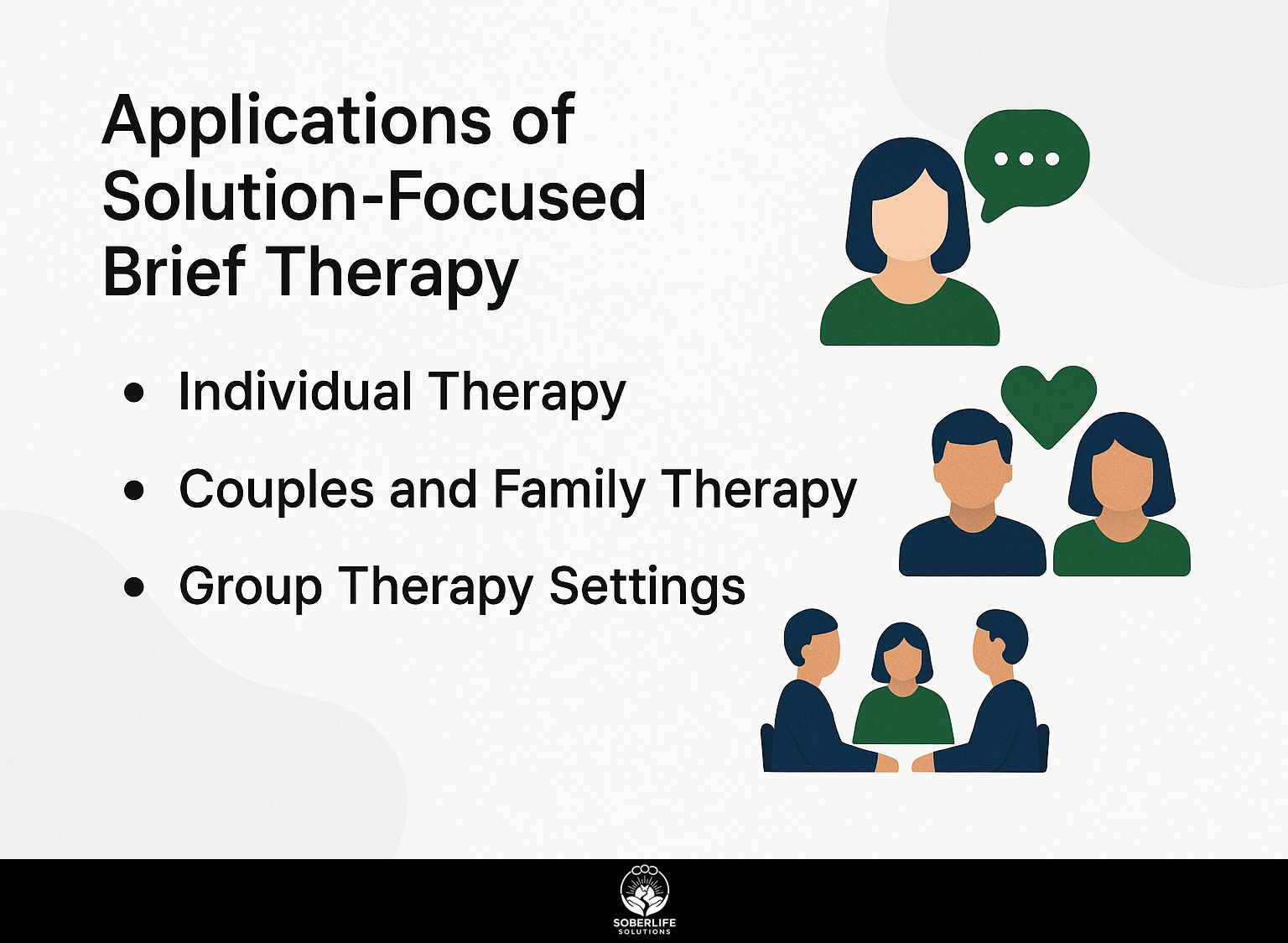
SFBT can be used in many therapeutic settings, helping with different problems from personal struggles to family relationships.
Individual Therapy
In individual therapy, SFBT helps clients set their own goals and use their personal strengths, leading to better emotional health and well-being.
For instance, a client struggling with anxiety might initially feel overwhelmed by their shortcomings. In SFBT, they find times they were calm and look into what helped them feel that way.
By setting small, achievable goals-like practicing mindfulness for five minutes daily-they develop a feeling of control. This method helped a recent client transition from feeling paralyzed by fear to recognizing their capability for calm and control.
Many clients notice a big change in their thinking and stronger coping skills after only a few sessions, showing that SFBT is a useful method in therapy.
Couples and Family Therapy
SFBT works well in couples and family therapy, promoting open communication and guiding families through issues by concentrating on strengths.
This approach encourages participants to identify exceptions to their problems by highlighting moments when things went well. For example, in a session, a couple might discuss a recent date they enjoyed, emphasizing what made it special.
Therapists often use scaling questions, asking clients to rate their satisfaction on a scale of 1 to 10, which helps to set specific goals for improvement. Families can improve how they talk to each other and solve disagreements by learning from good experiences. This helps create a more caring and supportive home.
Group Therapy Settings
In group therapy, SFBT promotes collaboration and shared learning, allowing participants to support each other in achieving their personal goals.
This team method helps people find what they’re good at and what tools they have. For instance, group members can share personal successes, helping others visualize achievable outcomes.
Methods such as the Miracle Question allow people to share their goals and hopes, helping them align on a shared objective. Using scaling questions allows participants to gauge their progress and celebrate small victories collectively.
Tools like whiteboards or online breakout rooms can make these discussions easier by allowing you to track how individuals and groups are doing, and by building community support and accountability.
Effectiveness and Research Evidence
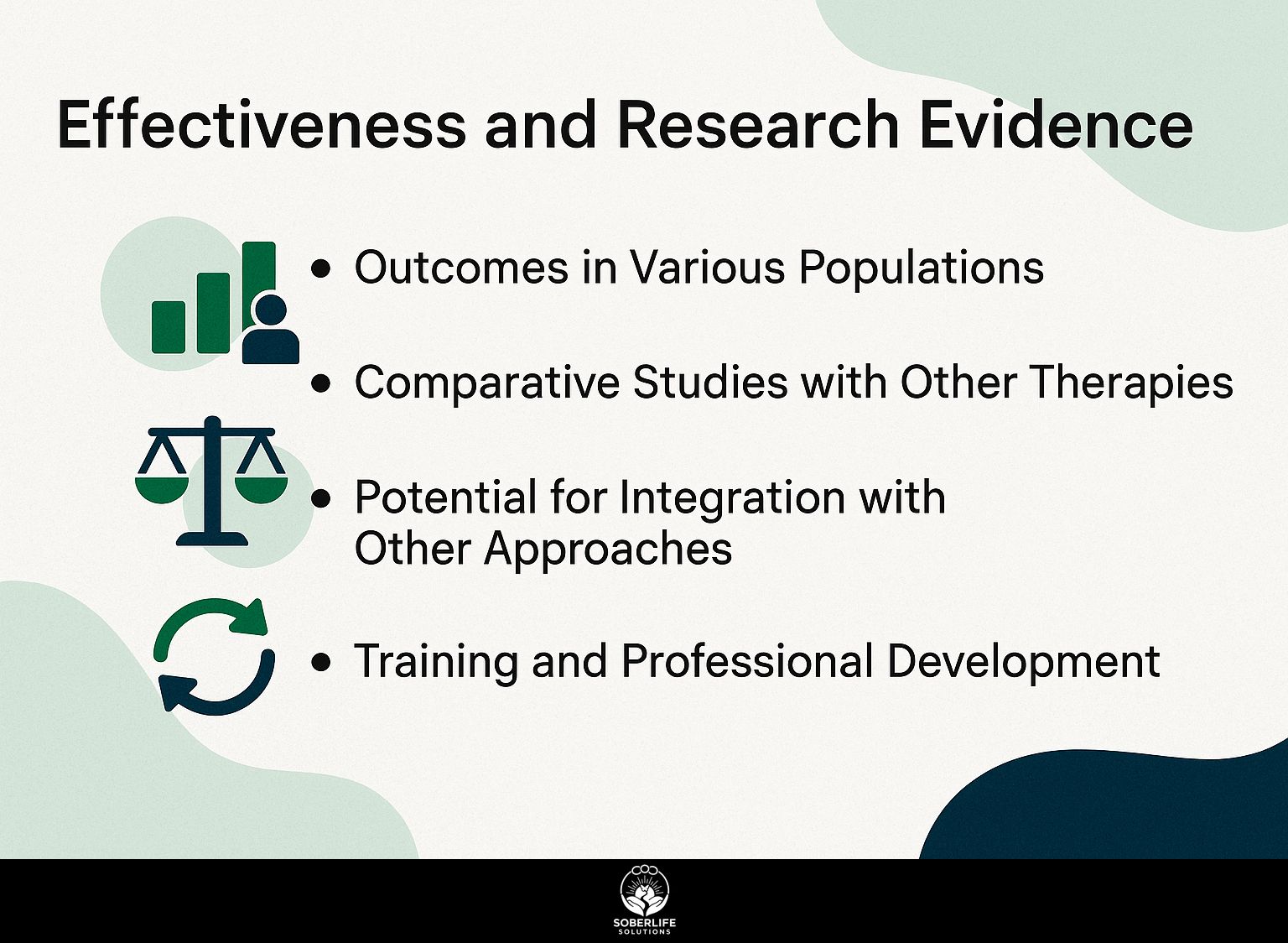
Many research studies have shown that SFBT works well with different groups of people, resulting in better mental health and behavior.
Outcomes in Various Populations
SFBT has yielded significant positive outcomes in treating diverse populations, including those facing mental health disorders like depression and anxiety.
Studies have shown that SFBT can lead to a 50% reduction in symptoms for depression within just six sessions. For instance, a meta-analysis published in the Journal of Brief Therapy highlighted an 80% client satisfaction rate among participants from low-income backgrounds.
Another study indicated a significant decrease in anxiety symptoms, demonstrating its effectiveness across various demographics.
In SFBT, therapists often use methods like ‘exception questions’ and ‘scaling questions’ to help clients imagine their desired outcomes. This method helps people feel in control and encourages focused progress.
Comparative Studies with Other Therapies
Comparative studies reveal that SFBT often produces similar or superior outcomes when contrasted with traditional therapeutic methods, demonstrating its viability in treatment.
For instance, studies indicate that SFBT can resolve issues in an average of 5-10 sessions, compared to 10-20 sessions for traditional therapies like CBT.
Clients often report higher satisfaction rates with SFBT due to its goal-oriented focus and practical solutions.
Tools like the Scaling Questions technique or the Miracle Question improve effectiveness, helping clients imagine success and monitor their progress.
In environments such as schools or organizations, these methods allow for quicker answers, making SFBT a solid choice for different therapy contexts.
Potential for Integration with Other Approaches
Combining SFBT with cognitive-behavioral therapy and other methods can lead to a well-rounded treatment plan that meets the detailed needs of clients.
For example, when a client deals with anxiety, using SFBT’s solution-focused approach along with CBT’s methods for changing thought patterns can improve results.
A practical way is to start sessions by setting clear, realistic goals using SFBT, then apply CBT’s techniques to find and question negative thought patterns.
Mindfulness practices can be integrated to help clients remain present and reduce anxiety.
Tools like the CBT Thought Diary or worksheets designed for SFBT can facilitate this integration, providing a structured yet flexible approach to therapy that caters to individual client goals.
Training and Professional Development
Continuous training in SFBT gives therapists the ability to use solution-focused methods and meet the different needs of clients effectively.
There are many great resources for therapists looking to improve their SFBT practice.
The Solution Focused Therapy Association offers workshops and online courses that allow flexibility for busy professionals.
Books like ‘Solution-Focused Brief Therapy: 100 Key Points and Techniques’ offer practical strategies to use in sessions.
Attending conferences like the International Brief Therapy Conference can help therapists connect with experienced professionals and learn about the newest research.
By using these tools, therapists can keep up with new techniques that improve client outcomes.
Frequently Asked Questions
What is Solution-Focused Brief Therapy?
Solution-Focused Brief Therapy is a type of psychotherapy that focuses on finding solutions to current problems rather than dwelling on the past. This method focuses on short-term goals, helping people recognize and use their strengths and resources to reach their desired results.
What is the main difference between Solution-Focused Brief Therapy and traditional therapy?
The main distinction is that Solution-Focused Brief Therapy focuses more on the present and what lies ahead, instead of what has happened in the past. It also focuses on finding solutions and building on strengths, rather than analyzing problems and their causes.
What are some common techniques used in Solution-Focused Brief Therapy?
Some common techniques include scaling questions, miracle questions, exception questions, and the use of positive language to focus on solutions and desired outcomes. The therapist also encourages the client to set specific and achievable goals.
Who can benefit from Solution-Focused Brief Therapy?
Solution-Focused Brief Therapy can benefit individuals, couples, and families who are experiencing a variety of mental health issues, including depression, anxiety, relationship problems, and behavioral issues. It can also be used in workplace settings to improve communication and productivity.
Is Solution-Focused Brief Therapy effective for all types of problems?
Solution-Focused Brief Therapy is best suited for specific and short-term problems. It might not work as well for complicated or ongoing problems, as these might need a longer and more detailed therapy.
How long does Solution-Focused Brief Therapy typically last?
The length of therapy varies depending on the individual and their specific goals. Solution-Focused Brief Therapy usually takes about 5 to 10 sessions. It can also be used as a supplement to longer-term therapy, or as a standalone approach for certain issues.

